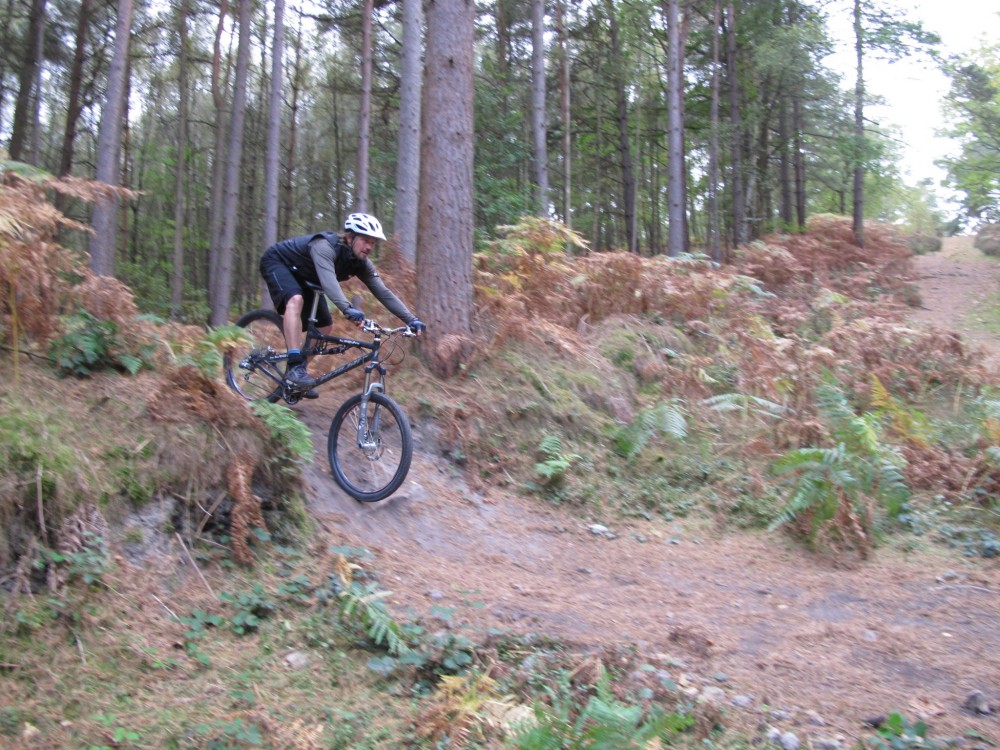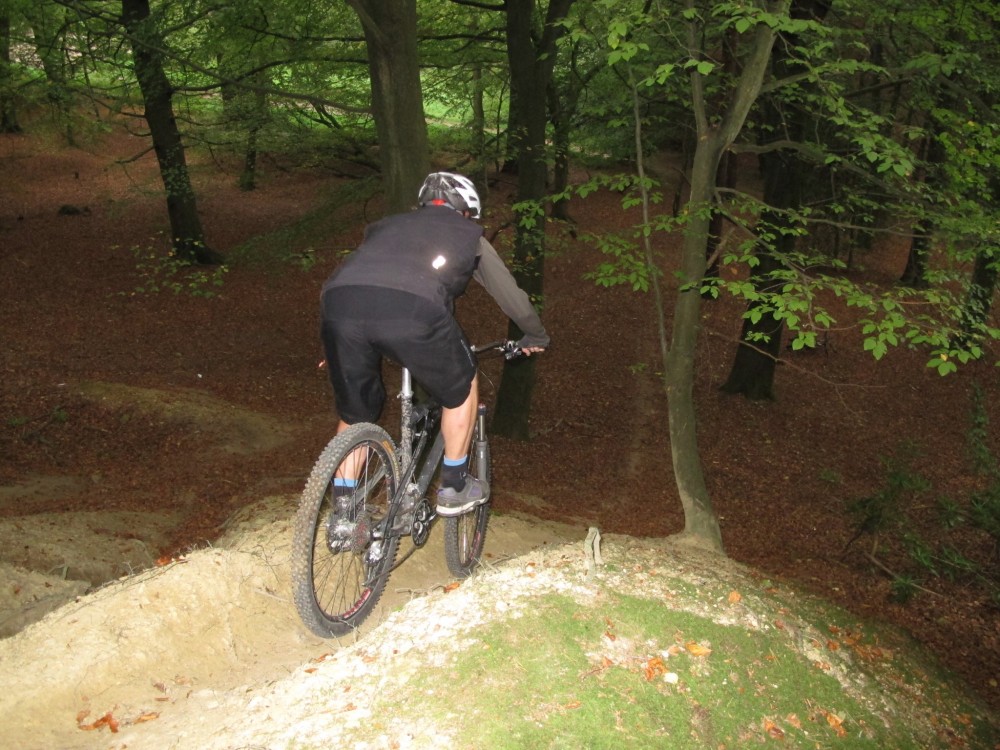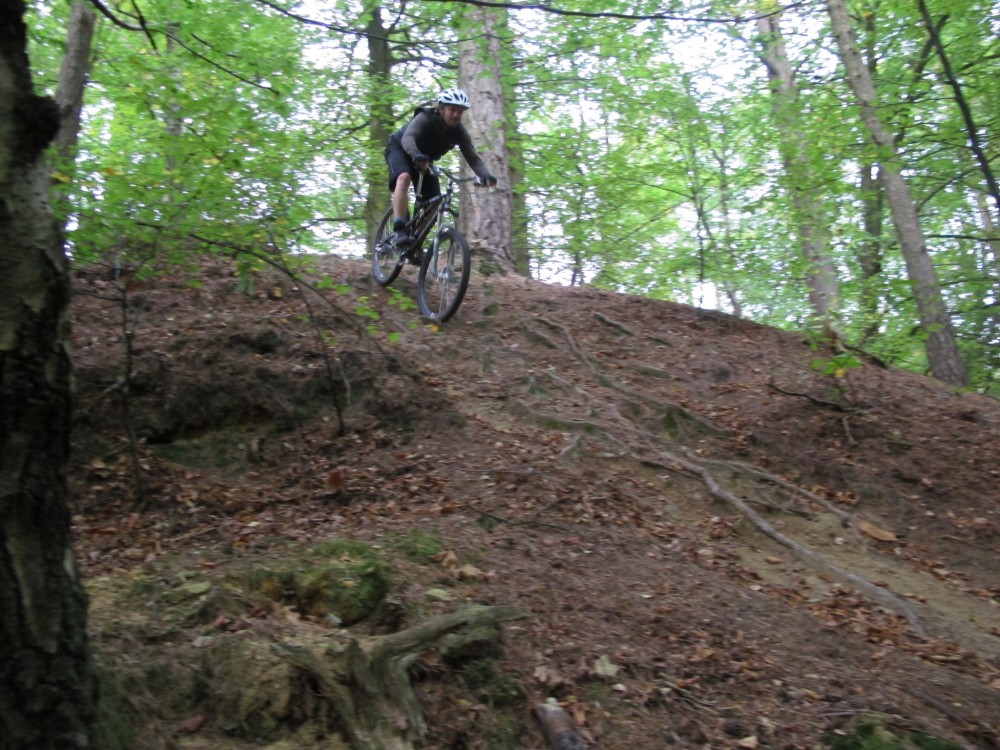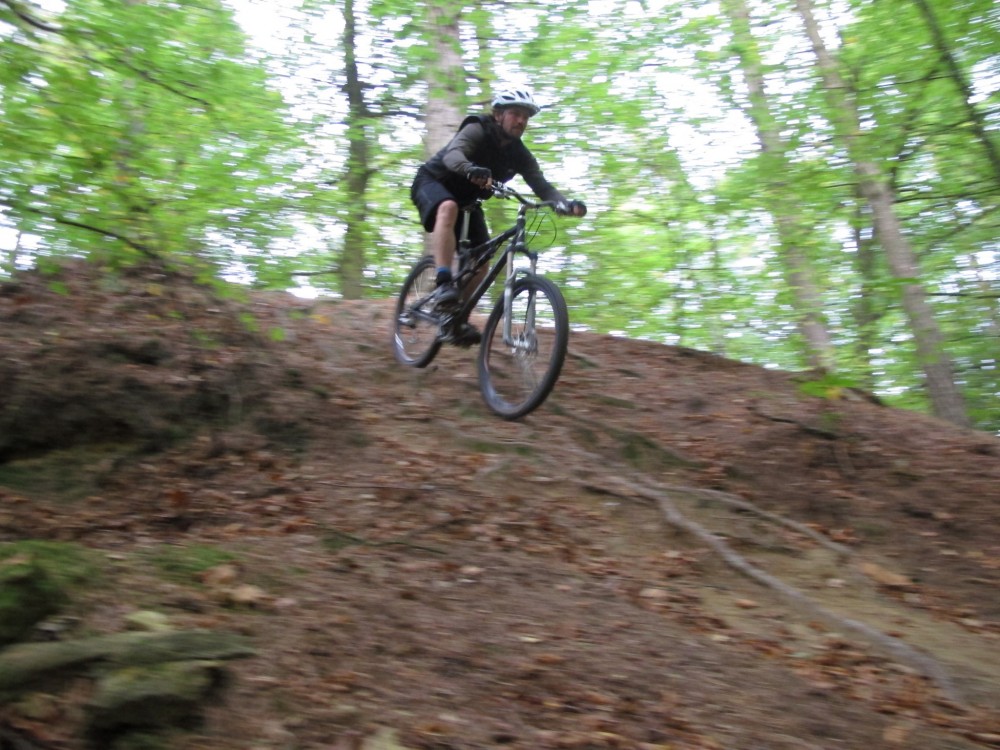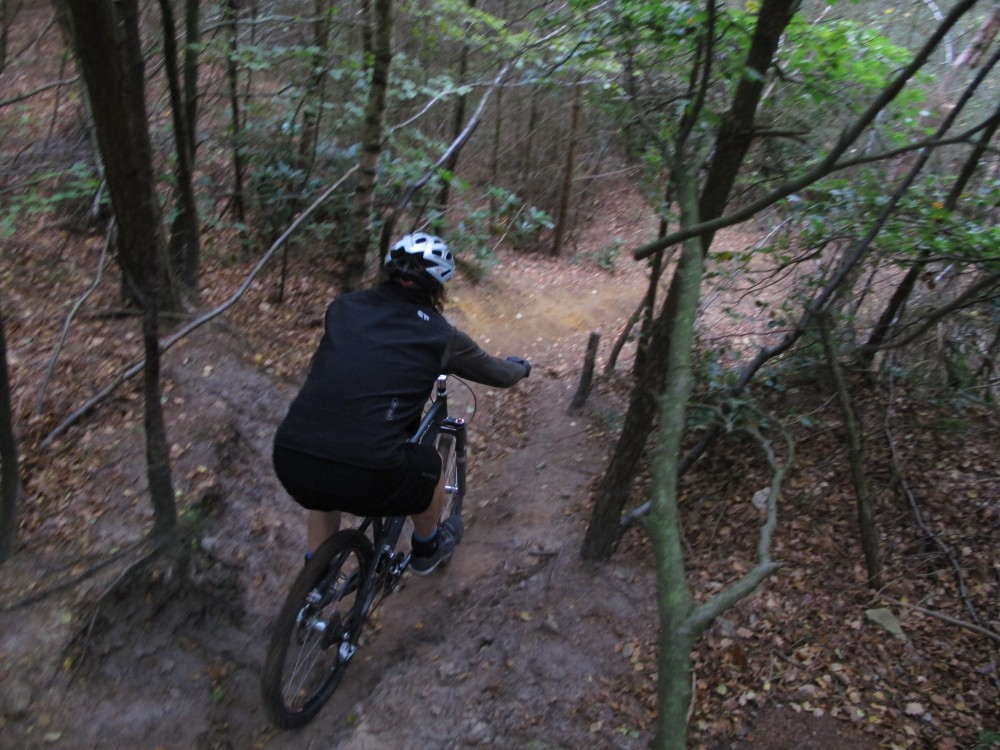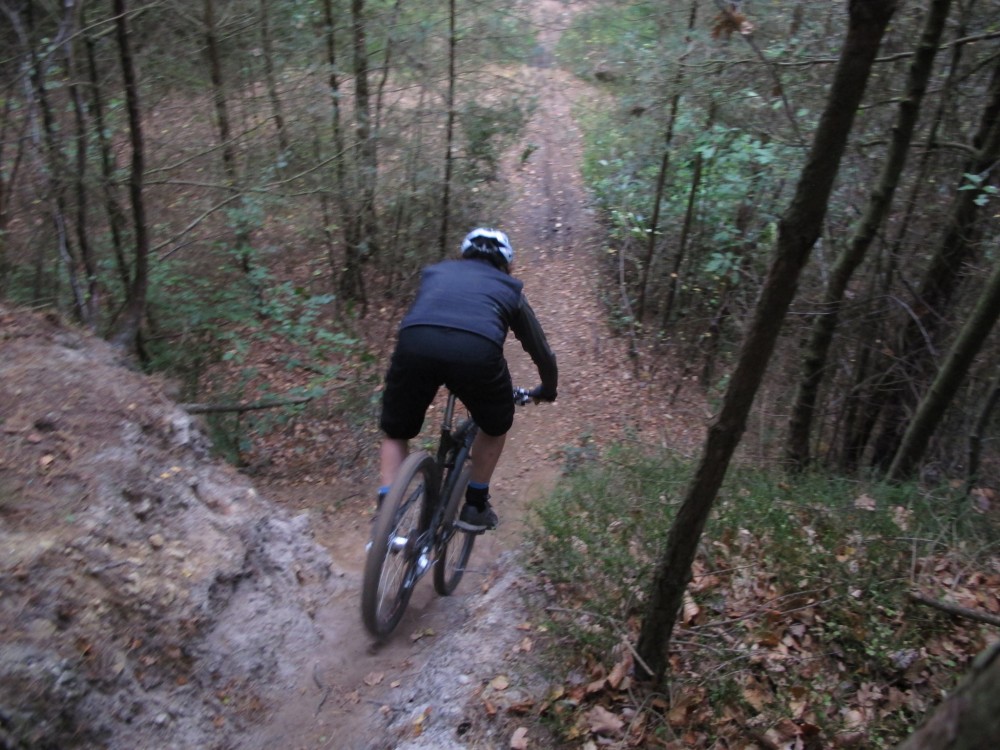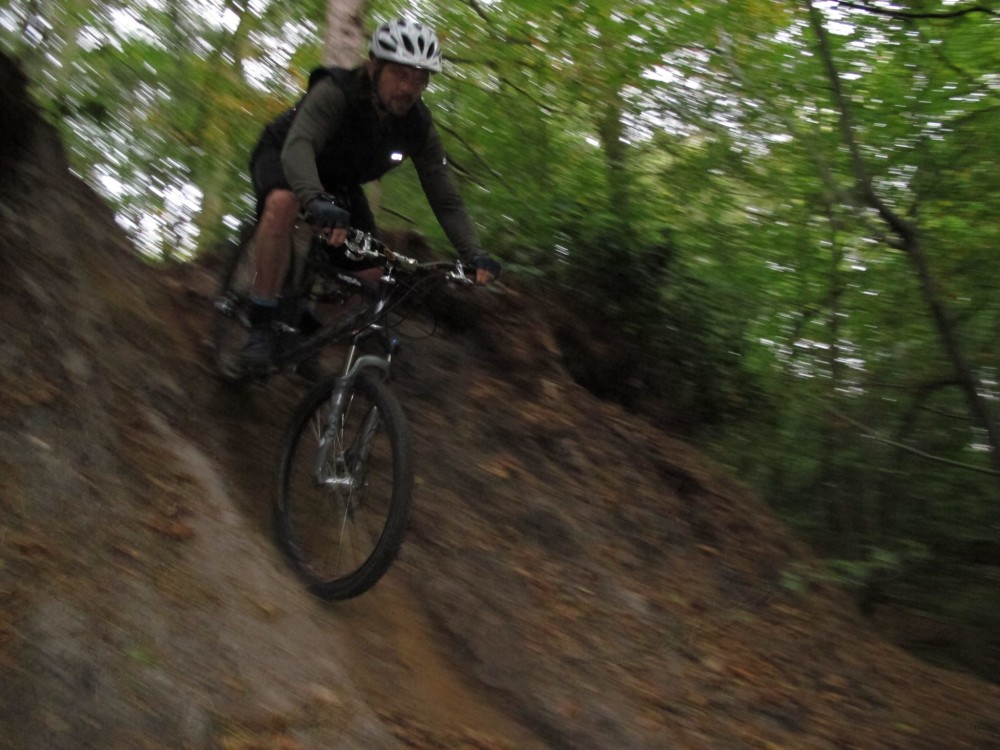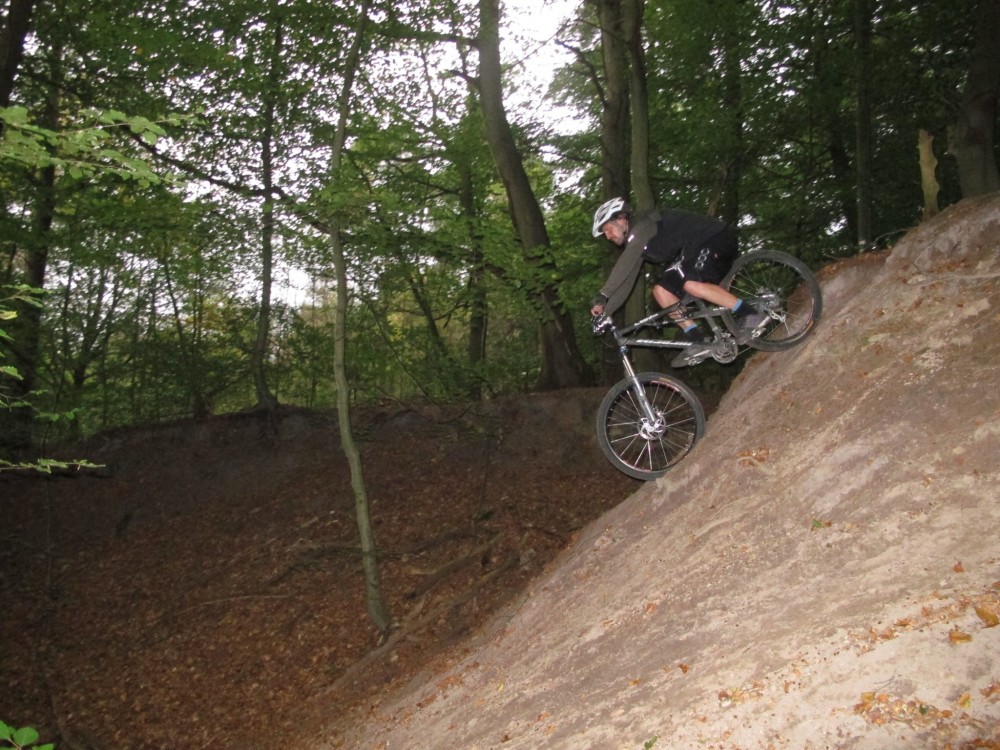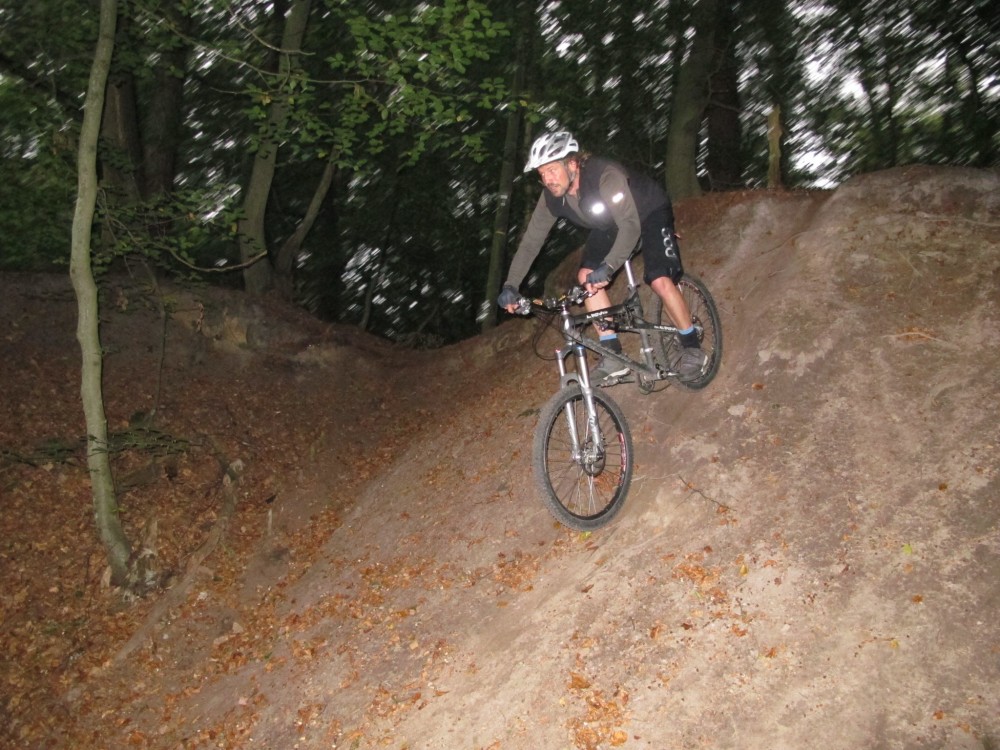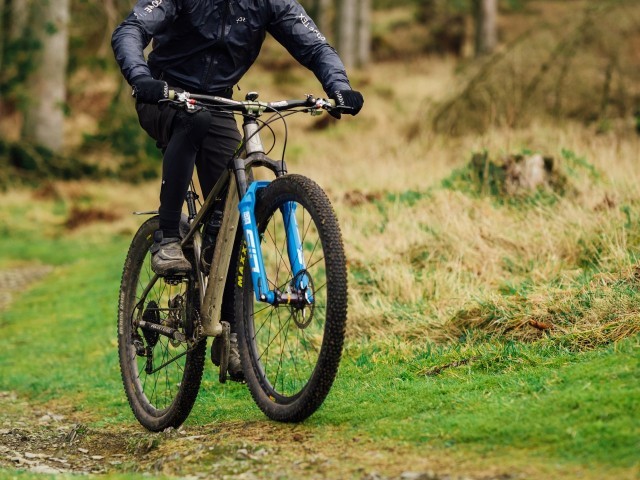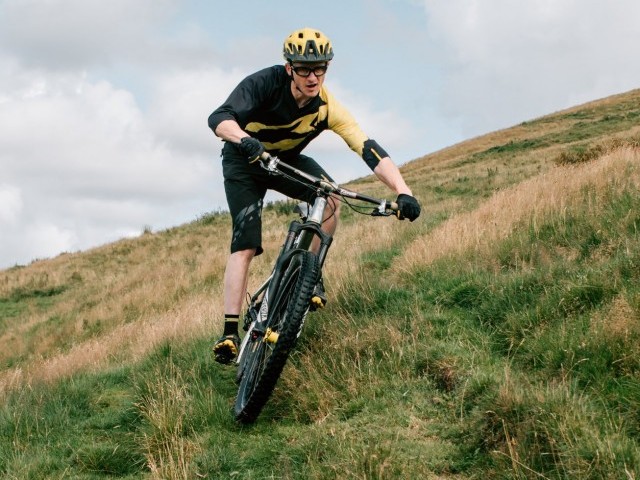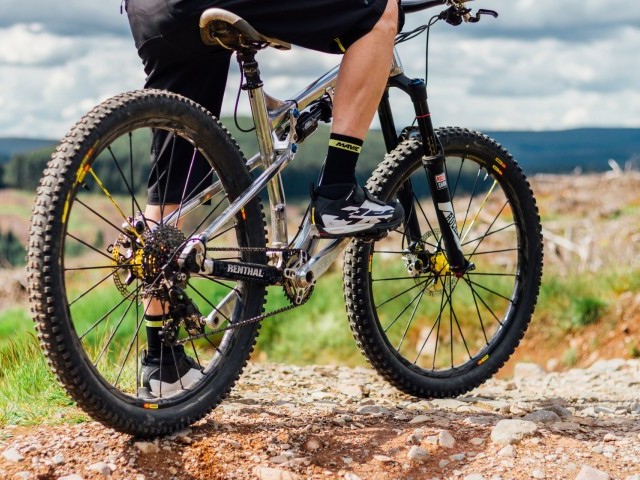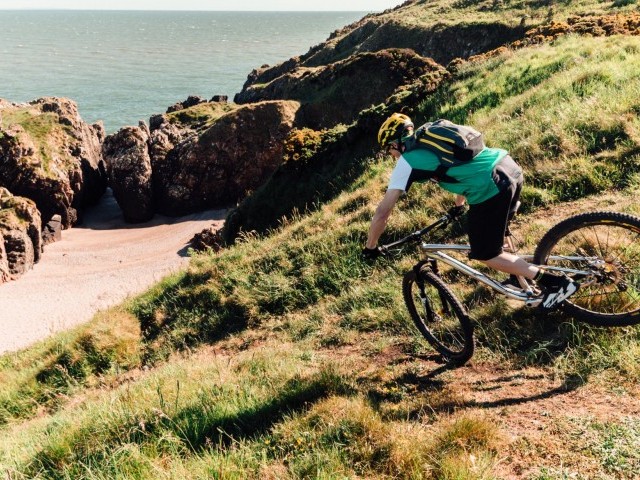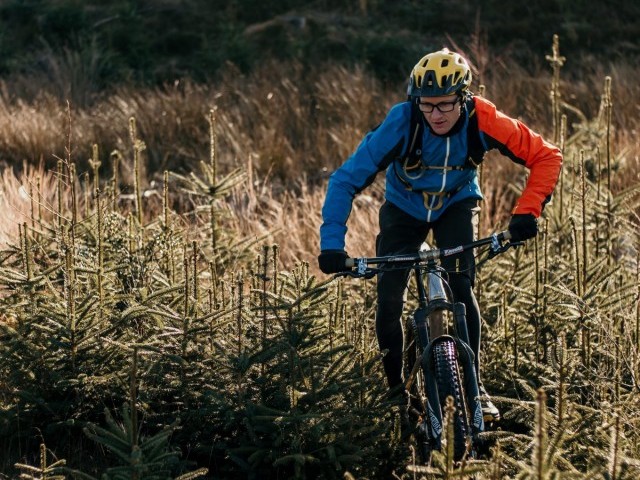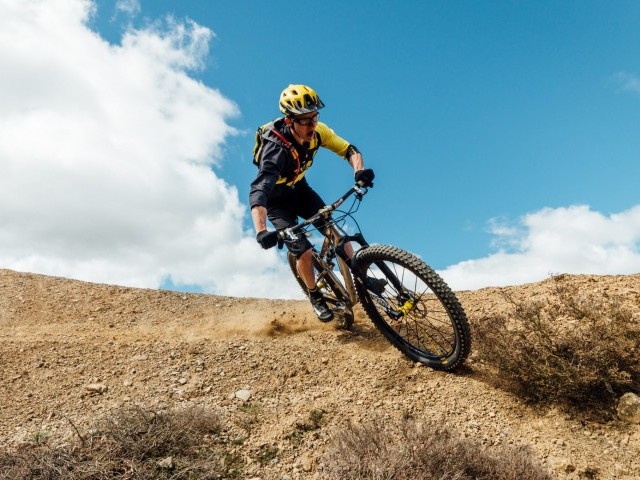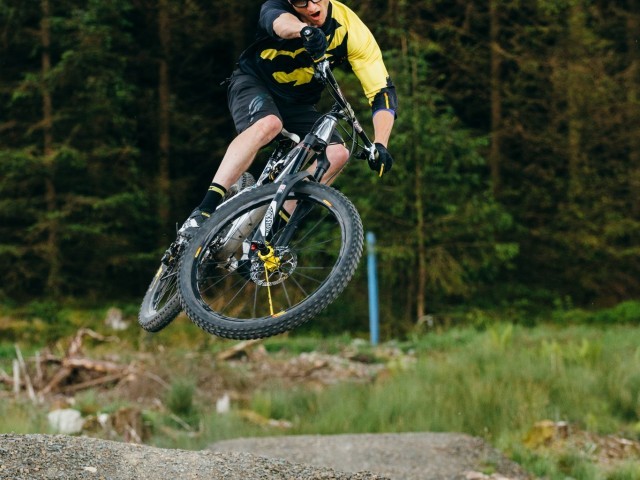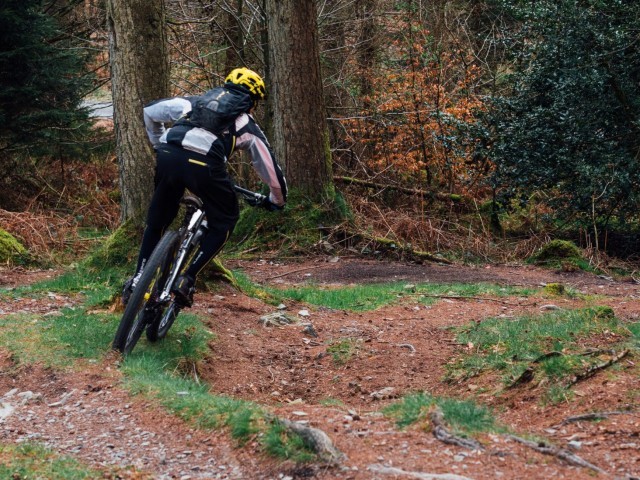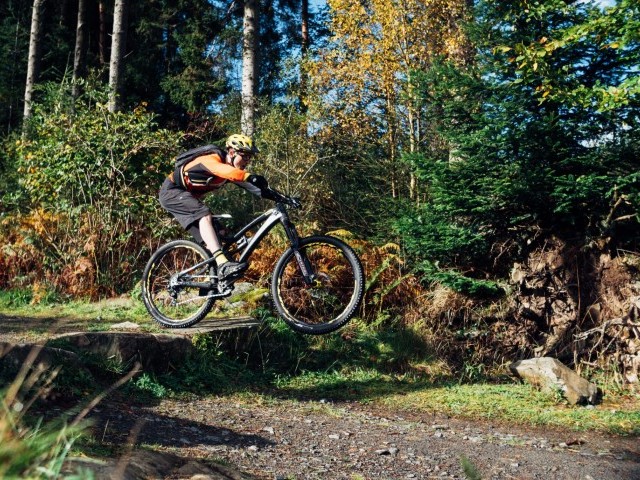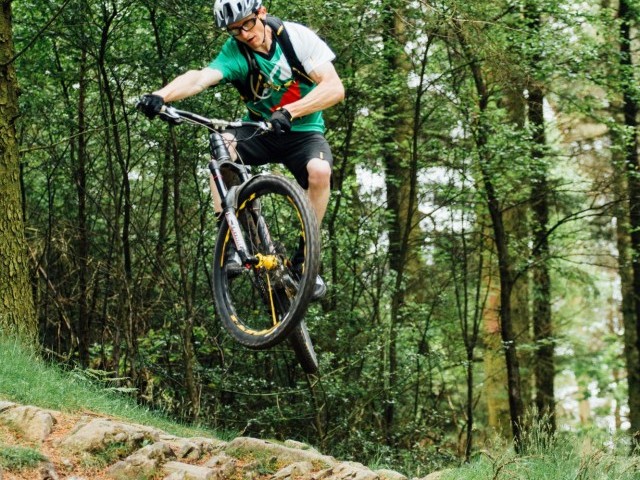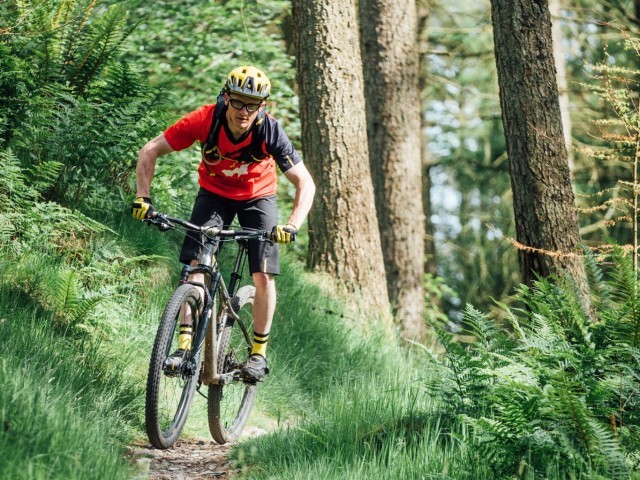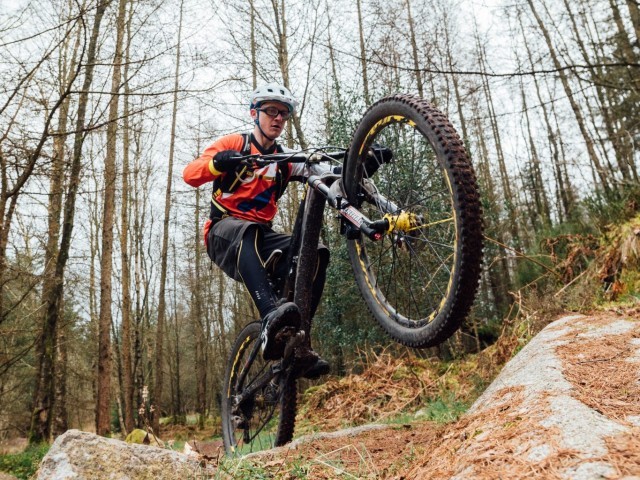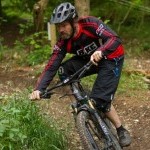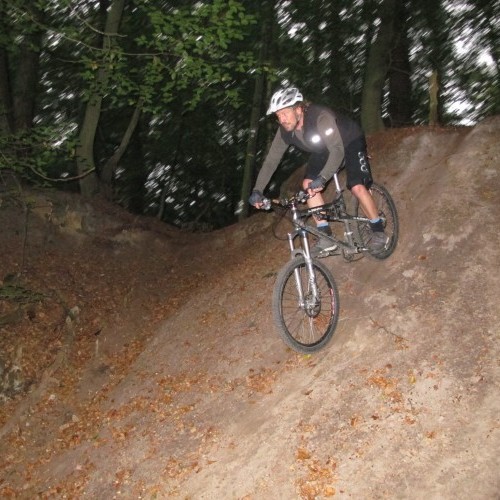
Short Sharp And Steep
Technique / Skills
Introduction
What goes up must ultimately come down. Long flowing descents are for many the highlight of their ride. Mother nature and trail designers alike do not always have the faint hearted in mind and when sections become suddenly very much steeper it is easy for fun to give way to fear, to have your flow broken as your mojo fades or, in more extreme cases, disappears in a cloud of dust.
Firstly let us deal with semantics. To many riders a short sharp steep section will be referred to as a ‘drop-off’, for the sake of argument that is how I’ll be referring to them through this article. We are not talking ‘drops’ (which will require the wheels to leave the ground) but where the trail ahead ‘drops off’ at a dramatically increased gradient but can still be rolled.
Mastering short, steep sections of trail will allow you to undertake a far wider range of trails and terrain. No-one likes the feeling of having to dismount and walk a section (added to which walking a bike down can be as (perhaps even more) precarious than riding it. Armed with both the correct knowledge, and the ability to apply that knowledge to your riding, less and less will you be forced to dismount and perform the often-comedic routine of descending a steep section pushing your bike with all the grace and dexterity of Bambi on a frozen pond.
Drop offs put both your physical and your psychological skill set to the test. Understanding the physical elements of your riding is one thing, having the nerve to apply them when psychologically challenged is another. Flight based responses (as we have identified in other issues) are instinctive but wont necessarily help. Learned responses required to master steep terrain can quickly be developed to replace ‘gut instincts’. Gut instincts are reactions to the perceived threat and danger you face but have little to do with the dynamics of riding a bike and good technique.
Although gradients, trail surfaces and technicality of sections will vary greatly the underpinning principles that will enable you to tame them will not. The same core principles and skills elements will need to be considered for every ‘drop off’. The degree to which these skills are applied might change, margins for error may narrow and penalty for failure may rise but the thinking behind the techniques, the physics, will not.
Underpinning Principles: Under-rotation
We have already identified the principle of under-rotation in an earlier issue (issue 2) and seen how understanding this concept will help with various aspects of riding. Although beneficial to your riding in a general sense, applying this principle either knowingly or unknowingly is crucial when it comes to riding ‘drop offs’.
To recap, under-rotation is concerned with how your mass interacts with the bike - your mass should be driving the bike not simply balanced on top of it. If the bike stalls or checks against terrain, pitches forward sharply, or is slowed by you applying the brakes, you need to consider what will happen to your mass. You do not want it to fly up and over bike. Set up your core connection with the bike correctly and you will allow your mass only to push down, into and through the bike. Under rotation will not only ensure that you keep the bike between you and the ground but will help drive the bike though a section, gain traction, brake with confidence and control where necessary, or pump for power and speed. It is a fundamental principle that needs to be applied.
‘Under rotation is not a case of simply getting your weight ever further back on the bike and seeing it as such (or refuting it’s importance because you don’t understand this) this is a mistake that will leave you wanting.’
We will look at how various core skills contribute to this later in the article but as a recap consider the following:
On the flat your with cranks level (and heels dropped) feet will be equally distanced fore and aft of the bottom bracket. Keeping equal pressure on each foot is key to a balanced position on the bike. Your hips slightly rear of the bottom bracket and your shoulders slightly in front of that point will mean that you core mass is centered. As terrain steepens you are going to have to shift your body position to keep that equilibrium. It is easy to allow your body to rotate too far forward as the nose of the bike drops into a descent. If this happens your mass will be driven towards the front of the bike and the potential pivot point of the front hub. Once hips overtake your feet your legs no longer bear so much of your weight and you cannot push force down, into and through the bike effectively. You will have gone from driving the bike to being conveyed by it - any attempt to control your speed is going to put much more pressure on your arms / hands (they are all that is left from stopping you overtaking the bike) and restrict your ability to control your speed dramatically. Your centre of gravity will be raised from the low point of the bottom bracket to a high point above the bars, which is a long way from ideal. As your bike reaches the bottom of a drop off and the compression at the front end is at it’s maximum you’ll struggle to stop your mass getting driven even further to the front of your bike or beyond it. There are times shifting your weight forwards is desirable and necessary for sure, but it should be a conscious decision to so and controlled rather than simply slumping or being thrown there because momentum and poor core understanding have combined to pin you there. Dropping the wrist will help to ensure that when weight is pushed forward it travels down and through the bars not simply on top of them and help to drive the bike.
Underpinning Principles: Projection
Again this is a principle that needs to be understood and applied to all aspects of riding but as things get suddenly steeper there is more to do and it is important not to get caught up in the moment but be thinking and making decisions further ahead of the bike. Your thinking should be done before your ‘doing’. Knowing what you want to be doing way before you need to do it will have positive connotations both physically but also mentally. It will allow you as a rider to keep calmer and be more considered in your approach rather than riding by the seat of your pants...you wont find much decision making capacity down there! Riding blind into a drop off having not seen it before you are indeed going to have to make some pretty quick decisions and that may be as you are passing the point of no return but that is still not an excuse to stare down the barrel of your forks and try and affect an outcome that is already inevitable. You don't need to have seen the exact nature of the drop as you ride in if you have already developed good muscle memory and trained your body to react in a certain way when presented with a certain scenario. A successful outcome relies on having experienced similar terrain and to a certain degree developed a level of ‘unconscious competence’. If you are not happy that you will react with enough speed and in the right way to a section that lies ahead you should consider having a look at it first. When approaching a drop off, by it’s very nature you may not be able to see the section. Controlling your approach speed might give you enough time to make your decisions (or stop before the point of no return) alternatively you may chose to take a look at it first before riding in.
Projecting ahead of the bike does not always require you to be on it!
You and Your equipment
As ever if your bike lets you down it will effect your performance. Of particular relevance when dealing with drop offs is your ability to control your speed, shift your weight and deal with compression as you hit the transition. With that in mind correctly performing brakes are going to be important. A brake in need of a bleed may well work sometimes and others fail you leaving the lever clamped to the bar but not the callipers to the rotor. A brake that does not work at all is arguably less danger than one that works intermittently. If you know it wont stop you, you are not going to attempt a section which requires it, if it fails you when you decide you need it, trouble will not be far way. Equally important is your ability to employ the brake from the position you are in without the need to roll your wrists forwards which will weaken you core interaction with the bike and can lead to over rotation and less ability to deal with compression. You need to be able to still reach your levers with a dropped wrist when the bike becomes inverted to some degree. Raising the level position SLIGHTY will allow this. Just to be clear that does not mean they should be parallel to the ground but slightly raised from 45 degrees and easy to reach when the bike pitches forward and you shift slightly rearwards.
Saddle height can infringe your ability to move freely around the bike. As the bike rotates forward you need to be able to allow the saddle to pass between your legs and not rotate you forwards at the same rate. If your saddle is too low and you may feel less stable additionally when it comes to pedalling you will suffer big time. A dropper post will allow you to quickly adjust your bike to the terrain but finding an optimum point where pedalling is not compromised too greatly but freedom of movement is maintained is the ideal. A by product of riding with a dropped heel means you can get full leg extension when pedalling but have good clearance when standing on level cranks.
The saddle is not the only thing that can restrict movement. A low hanging baggy short might let everyone know who makes your underwear, it may make you ‘feel down with the kids’, but if they snag on the nose of your saddle as the bike pitches forwards it will cause issues. Equally if it stops the saddle passing back through your legs as the bike levels off at the bottom you’ll create problems for yourself. Stuck too far forward on the way down or hanging too far out the back when pass through the transition are both problems easily avoided. Don’t let your clothing result in you becoming quite literally a fashion victim. As far as I am aware, looking ‘cool’ doesn’t guarantee a shorter waiting time for an x-ray.
Suspension is going to get a work out. Your forks will be put through their paces. Experimenting with compression rates and rebound will allow you to fine tune your performance. To soft and forks can bottom out too early, running them to rigid and you are not going to get much assistance from them and they will compensate less for any shortcomings in technique and correct body positioning. Don’t forget as vital as the bikes suspension set up is, you the rider can use the 18 or so inches of travel that arms and legs allow to good effect, but you must stay supple - as with any technical section getting ‘tight’ is going to cause problems.
Footwork
As alluded to time and time again, your feet are your primary point of contact and losing contact with your pedals will have serious repercussions, as terrain gets steep. Generally your heel should be dropped and unless pedalling or cornering, cranks should be level. As the bike rotates away from you keeping heels dropped will ensure your mass stays where you want it and your feet stay planted to your pedals. An added benefit is that as the rear wheel wants to move up and over bumps a dropped heel will encourage you to suck up the back wheel rather than be rotated forward. It will also allow you to push into the bike and counter momentum that will potentially start to push you forward as you try and control your speed. On a steep slope your wheelbase is effectively shortened dramatically so the margin for error in terms of getting too far forward is narrowed. Keeping your heels dropped (and hips behind them) allows you to use your legs to control and deal with the forces of momentum. It will help to ensure that your mass contributes positively to the braking process rather than simply overtaking the bike. Up on your toes, heels raised, you are asking at worst to be rotated forward to a point of no return. Even if you don’t get beyond the point of no return you will be putting far too much burden on your hands and arms. If you are in doubt think which is easier, a push up or squat? With your weight remaining through your feet you are far less likely to find yourself gripping on ever tighter. Gripping too hard to control over rotation will lead to a general tensing of the arms and thus deaden your body’s natural suspension.
The final consideration with footwork is maintaining a level crank. As the bike rotates forward and you shift clear of the saddle it is easy to end up with rear foot dominance and as a result more weight rocks onto your back foot. Your trailing foot will then drop from the level position to a lower point. As the front wheel pitches down you do not want a pedal catching on the lip of the drop. As you rotate back increase the pressure on your lead foot so as to keep your cranks level. Your rotation backward and down is around the pedal axles not the bottom bracket.
Body Position
You are going to have to allow the bike to rotate forward into the drop off. Rotating forward at the same rate might be okay if:
- You are not planning anything in the way of speed control.
- The transition at the bottom is not too severe, more rounded rather than a sharp change.
- The trail surface is smooth and front wheel’s progression is not going to be hindered by roots, rocks, etc.
- You simply enjoy the pain associated with face planting.
Assuming all those boxes are not ticked you will need to allow the saddle to pass between your legs but it is not a case of extending as far back as your limbs will allow. Push so far back that your legs are fully extended and locked out and they wont be much use in terms of energy management. On top of this, when the bike levels off at the bottom you are going to struggle to get centred on the bike quickly enough and risk looping out. Once you have cleared the saddle it is more a case of softening the legs bringing your weight down as well as back. Hunkering down above the rear hub will allow you to deal with the bumps on the way down, control your speed and get central more easily as the bike levels off. Just clear of the saddle you can even afford to bring your upper body forward if desired - it should not feel that you are backing off from the trail by extending as far back as possible.
Speed Control
If every second is being counted then you will be trying to ride the section a fast as possible, less braking means less chance of overtaking the bike. If we do want to control our rate of acceleration however, then good braking technique is crucial. Remember that it is easier to affect your rate of acceleration than your rate of deceleration. Once panic sets in there is likely to be snatching at brake levers rather than any progressive braking. When gut instinct takes over (flight based responses) you are more likely to tighten up on the bike, more likely to drop your head and think only about the current situation and not think ahead of the bike. No doubt the bike is going to accelerate as you enter a steeper section or drop off. If it is a near vertical entry you are going to have to go with the flow to a degree but that does not mean just letting go and hoping for the best. Controlling the entry speed is a good idea. Go in too fast and you may well exceed the speed you are comfortable with and freeze up, tighten up or lose your nerve all together. On the other hand if your slow speed balance skills are not great going in too slowly will cause more problems than it solves. Wobbling from side to side at the lip is not ideal and will make sticking to your preferred line difficult. If you are approaching too slowly and find yourself wobbling it is probably a sign that you are not all there in terms of the psychological aspects of riding that drop off. Finally when it comes to speed control getting the balance between front and rear brake is important. On a steep enough slope (and certainly a drop off) a locked back brake alone will not slow you down in fact wont even stop you accelerating, all it will do is bounce around behind you at the mercy of every root and camber. This will send far more shockwaves through the bike bouncing you around more. Much of the speed control is going to come from correctly using your front brake. Locking this up is definitely not a good idea but certainly you will need to be using it. Overall you should be expecting your speed to increase through the section (like any other) so don’t panic when it does - keep a cool head and remember controlling your acceleration is one thing and more than possible - stopping is not.
The Psychological Factors
Commitment must be there at the entry point (this is not the lip but well before), it must remain high through the section and beyond, losing your nerve as the front wheel drops will have a very negative impact and invariably that will result in being parted from your bike. Confidence can rise and fall faster than a lift in the Empire State Building. Build confidence by building up the size and severity of drops. Success and repetition are the sure fire ways to keep confidence on the up. On the days you are less confident or when pushing yourself to new levels of technicality think through the section and ultimately if it doesn’t feel right save that drop for another day. ‘Giving it a go’ is not a positive frame of mind, don’t just think you can do it - know you can.
Controlling the emotions and not resorting to flight and flight responses is crucial - you will need to move dynamically and fluidly on various axis. Stay fluid, don’t hold your breath or brace yourself as if you are about to crash.
‘Get tight with fright and it could well be good night’.
Concentration as ever will require you to keep mentally as far ahead if the bike as possible. Think ahead, look ahead, don’t get drawn into the now. Look for positive outcomes - where you want to be, not where you do not.
As a rider you should ride into a section because you want to and are ready to both physically and mentally. Ride it because you want to not because your mate wants you to. A&E departments are often frequented by riders that were looking to save face... Only to find that the outcome was quite the opposite!
As with all techniques work on correctly applying your physical and psychological skills on drop offs within your capability where you can focus on technique over terrain and build up towards the steeper and more technical once you are happy that the foundations are strong. Riding drops and getting them right is a great buzz. It will open up a far wider range of trails particularly those off the beaten track, free from risk assessments and HSE guidelines. Developing your skills will add to your freedom to roam, so enjoy the ride and most importantly... Don’t forget the odd whoop of delight when you pin that drop off!
This technique article was in Issue 14 of IMB.
Related
By Richard Kelly
Richard Kelly has been riding bikes since forever, and teaching people to become better mountain bikers for over a decade. He’s always out in the Surrey Hills training riders, building trails and riding for himself whenever he gets the chance. His unique perspective on mountain bike technique has earned him fans the world over, with some speculating he is actually Jamiroquai or perhaps Jack Sparrow…




